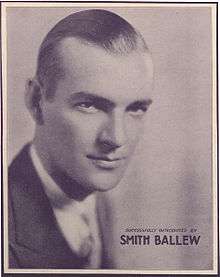Smith Ballew
| Smith Ballew | |
|---|---|
 Smith Ballew on a 1931 sheet music cover. | |
| Background information | |
| Birth name | Sykes Ballew |
| Born |
January 21, 1902 Palestine, Texas |
| Died |
May 2, 1984 (aged 82) Longview, Texas |
| Genres | Popular music, Jazz, Country music, Western movies |
| Occupation(s) | Vocalist, musician, orchestra leader, film actor |
| Instruments | Vocals |
| Years active | 1930s–50s |
Sykes "Smith" Ballew (January 21, 1902 – May 2, 1984) was an American actor, sophisticated singer, orchestra leader, and a western singing star.
Biography
Ballew was born in Palestine, Texas in 1902,[1] where he grew up attending local segregated schools. He attended Sherman High School, Austin College[2] and the University of Texas.
During his time at Austin College, Ballew and his brother, Charlie, formed the Texasjazzers orchestra.[2]
Starting in the late 1920s, he became one of the most recognizable vocalists on hundreds of dance band and jazz records, based in New York City. During this time, Ballew along with Scrappy Lambert, Dick Robertson, and Chick Bullock were the most prolific studio vocalists. He organized his own short-lived band in 1931.
Ballew began his singing career on the radio. In the 1930s he became known as one of the earliest of the singing cowboys on the movie screen. He did a series of musical Westerns for Paramount Pictures and one for 20th Century Fox, continuing in supporting roles until the 1950s.
Ballew was one of the hosts of old-time radio's Shell Chateau.[3]
Ballew's band's opening theme song was "Tonight There Is Music in the Air"; its closing theme was "Home".[4]
Between 1929 and 1935, he made scores of records issued under his own name for OKeh, the dime store labels (Banner, Domino, Jewel, Regal, Perfect, Oriole as Buddy Blue & His Texans or Jack Blue's Texans), Columbia, and Crown. Few of these popular records gave any indication of his future Cowboy style.
Ballew died at the age of 82 in Longview, Texas. He was buried in Fort Worth.[5]
References
- ↑ Lee, William F. (2005). American Big Bands. Hal Leonard Corporation. p. 63. ISBN 9780634080548. Retrieved 5 March 2017.
- 1 2 Zelade, Richard (2015). Austin in the Jazz Age. Arcadia Publishing. ISBN 9781625854537. Retrieved 5 March 2017.
- ↑ Terrace, Vincent (1999). Radio Programs, 1924-1984: A Catalog of More Than 1800 Shows. McFarland & Company, Inc. p. 302. ISBN 978-0-7864-4513-4.
- ↑ Walker, Leo (1989). The Big Band Almanac. Da Capo Press. p. 21. ISBN 0306803453. Retrieved 5 March 2017.
- ↑ Jasinski, Laurie E. (2012). Handbook of Texas Music. Texas A&M University Press. ISBN 9780876112977. Retrieved 5 March 2017.